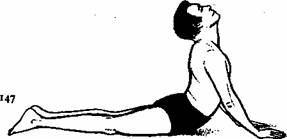| Yoga : Bhujangasana |
 Cobra Posture: Bhujangasana Bhujanga means 'cobra'. The posture takes its name from its resemblance to a cobra rearing, hood spread, to strike. It is one of the great classic poses of Yoga, and one that most beginners can accomplish in the modified form here to be described. The main difference between the adept's execution and that of the tyro is twofold: i. To avoid back strain, the beginner needs to have his hands placed in front of the shoulders rather than below them, which means a less severe back bend when the body is raised, ii. Until the lower back becomes very strong the beginner relies on the arms to push the body up and bend the back; whereas the adept slowly raises the upper body mainly with back power, though he calls on the thrust of the arms in the final stages of bending the spine. Lie flat on the abdomen, the legs stretched out together, the soles of the feet turned up and the toes flat. The arms are bent and the hands placed flat on the floor, the fingers pointing forward, five or six inches in front of the shoulders. The elbows are kept in against the sides of the body. The chin rests on the floor. To locate the correct position for the hands, place the palms flat on the floor in front of the shoulders, the fingertips in line horizontally with the chin. Inhaling, slowly raise the head, neck, and upper back successively, straightening the arms. You should feel the spine bending vertebra by vertebra. In the final position the arms are either straight or almost straight, and the body from the navel down to the feet presses on the floor. Most Yoga teachers instruct their pupils to raise the chin and bend back the head at the peak of the back bend, but a few prefer the more formal keeping of the chin level, so that the eyes are looking straight ahead rather than diagonally upwards. Rely as far as possible on the lower back muscles at the start of raising the head, neck, and upper body, completing the back bend with the assistance of pressure from the straightening arms. In the Cobra Posture as described here the arms will slope away from the shoulders more than is shown in the illustration. Hold the raised pose for ten seconds; then return slowly to the starting position, breathing out. If you stay in the pose longer than ten seconds, breathe freely after the first ten seconds. The Cobra Posture, performed slowly and smoothly, exercises the spine, vertebra by vertebra, from the lumbar region to the neck limbering and strengthening it. The front of the body - legs, abdomen, chest, throat, jawline - are all beneficially stretched. The circulation is stimulated, and the dense network of nerves in the spinal solumn receives an additional supply of blood. The pose improves digestion and relives constipation. It normalizes glandular activity, and is said to correct menstrual disorders and to be excellent for the reproductive organs. |
|
|